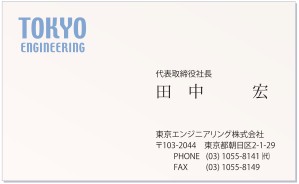- Meishi
-
A meishi (名刺) is a Japanese business card. The presentation of one's meishi to another person is more formal and ritualistic than in the west.
Contents
Presentation
A person is expected to present their meishi upon meeting a new business acquaintance. Meishi should be kept in a smart leather case where they will not become warm or worn, both of which are considered a sign of disrespect or thoughtlessness. The presenter extends the meishi, holding it with both hands, and introduces themselves by affiliation, position, and name. The card should be held at the bottom two corners, face up and turned so that it can be read by the person receiving the meishi.
When receiving a meishi, one should hold it at the top two corners using both hands. Placing one's fingers over the name or other information is considered rude. Upon receiving the meishi, one is expected to read the card over, noting the person's name and rank. One should then thank the other person, saying "choudai itashimasu" or "choudai shimasu", and then bow. A received meishi should not be written on or placed in a pocket; it is considered proper to file the meishi at the rear of the leather case. When meishi are being exchanged between parties with different status, such as between the president of a company and someone in middle management, it is proper that the person of lower status extend his or her business card in such a way that it is underneath or below the meishi being extended by the person in a higher position. If the meishi is being presented at a table, the meishi you received is kept on top of your leather case until you leave the table. If several people are involved in the meeting and you have several meishi, the one with the highest rank is kept on the leather case, and the others beside it, on the table.
The manner in which the recipient treats the presenter's meishi is indicative of how the recipient will treat the presenter. Actions such as folding the business card in half, or placing the presenter's meishi in one's back pocket, are regarded as insults[citation needed].
Appearance
Meishi give the most importance to the company and not the person's name. For example, meishi will feature the company name at the top in the largest print, followed by the job title and then the name. This is also the order in which Japanese introduce themselves; by their company and title first.
Usually the person's name is written in Japanese using both Chinese and Latin characters, along with the person's title and the company for which he or she works. Typically, the Chinese characters are printed on the obverse of the card, and the Latin on the reverse. Other important contact information is usually provided, such as business address, phone number and fax number.
Meishi may also contain a QR code to provide contact details in a machine-readable form[1], but this has not yet become a widespread practice. According to a 2007 survey, fewer than 3% of Japanese people own a meishi with a QR code printed on it.[2]
A Japanese executive or official usually has two business cards; one, in Japanese, used Japanese order and is intended for fellow Japanese. The other, with the name in Western order, is intended for foreigners.[3]
Dimensions
Traditionally, meishi are produced in an old Japanese paper size called yon-gō(4号, 91×55 mm)[4][5], although the equivalent metricated size of 90×55 mm is also gaining popularity.[6] It was once customary to use cards of a smaller size called sangō (3号; 85×49 mm) with rounded corners for women's meishi[7], but this size is no longer common.
See also
Notes
- ^ Japanese QR codes provide marketers a glimpse of the future
- ^ 2007 survey results (Japanese)
- ^ Terry, Edith. How Asia Got Rich: Japan, China and the Asian Miracle. M.E. Sharpe, 2002. 632. Retrieved from Google Books on August 7, 2011. ISBN 076560356X, 9780765603562.
- ^ http://www.ictnet.ne.jp/~meishi/ (Japanese)
- ^ http://digitalmeishi.cart.fc2.com/?ca=6 (Japanese)
- ^ See, e.g., http://www.adobe.com/jp/special/creativesuite/portal/guides/cs2_01_52.html (Japanese),
http://www.washiya.com/shop/namecard/index.html (Japanese),
http://www.kenseido.co.jp/shop/kps/namecard.html (Japanese) - ^ http://www.youmeishi.com/contents/product/paper.html (Japanese)
References
- De Mente, Boye (2004). Japanese Etiquette & Ethics in Business (6th ed.). Boston: McGraw-Hill. ISBN 0071448152.
External links
- Meishi: The Art of Introductions. Review of a 2007 exhibition of meishi at the Printing Museum, Tokyo, with photographs.
- Meishi: Japanese Business Card Exchange, Translation & Etiquette. Cultural Tips on the Etiquette of Exchanging Business Cards in Japan and information on Japanese business card translation.
- Japanese Business Card Samples. Exchanging business cards in Japanese culture and business card translation and printing.
- Japanese Business Card Translation Samples. Examples of western-based English business cards translated and typeset into bilingual Japanese meishi.
Categories:- Business cards
- Japanese stationery
- Ephemera
- Japanese business terms
- Japanese words and phrases
- Japanese culture
- Japanese society
Wikimedia Foundation. 2010.

